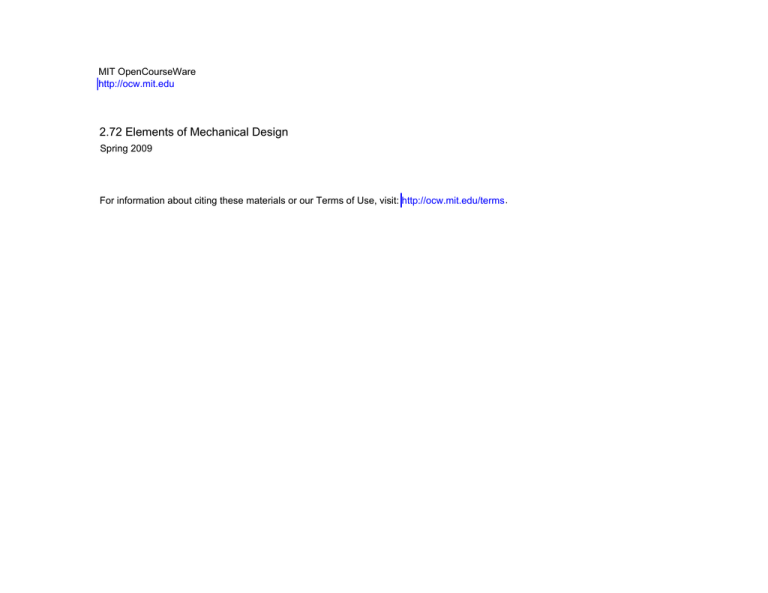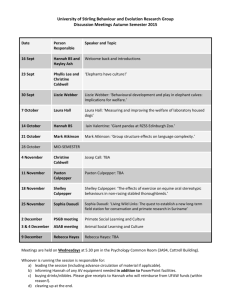
MIT OpenCourseWare
http://ocw.mit.edu
2.72 Elements of Mechanical Design
Spring 2009
For information about citing these materials or our Terms of Use, visit: http://ocw.mit.edu/terms.
2.72
Elements of
Mechanical Design
Lecture 18:
Friction-based elements
Reading and plans
Reading:
14.1 – 14.7
16.2, 16.6, 16.9
Today:
Friction-based elements
© Martin Culpepper, All rights reserved
2
Friction-based machine elements
Purpose:
Bring two bodies to same relative speed
Friction forces do the work
Force/Torque and Mass/Inertia are in play
Used in many types of ubiquitous machines
Drum brakes
Disk brakes
Clutches
etc…
© Martin Culpepper, All rights reserved
3
Clutches
www.tech.plymouth.ac.uk/sme/desnotes/clutlabe.jpg
Courtesy of David Grieve. Used with permission.
© Martin Culpepper, All rights reserved
4
Drum brakes
Images removed due to copyright restrictions. Please see
http://www.carbibles.com/images/drum-double.jpg
http://peugeot.mainspot.net/glossary/14_drum_brake_assembly.jpg
Can you imagine how much
fun it is to put this together…
What would be problematic?
© Martin Culpepper, All rights reserved
5
Disk brakes
Images courtesy of phaty on flickr and Wikimedia Commons, http://commons.wikimedia.org
What are the holes for?
© Martin Culpepper, All rights reserved
6
Perspective on heat, back of the envelope
Assume you need to stop a 2 ton truck: 65 to 0 mph;
how much energy must be dissipated as heat/sound?
Assuming that this happens so fast that the steel
components of the brake absorb the heat (assume
little energy goes into sound/vibration) before it is
taken away by convection or conduction… what max
magnitude of ΔT are we looking at? (e.g. worst case)
Really need modeling software to do this properly but
rough analysis is enlightening…
© Martin Culpepper, All rights reserved
7
Types of actuation
Pneumatic/hydraulic (e.g. pistons)
High force (hydraulic)
Inexpensive (pneumatic)
Maintenance (hardware/leaks & fluid)
Magnetic (e.g. solenoids)
Low maintenance
Fast reaction time
Ease of control
Mechanical (e.g. lever)
Moderate force
Moderate maintenance
© Martin Culpepper, All rights reserved
The best thing to do is to make
a matrix of FRs and DPs and
then select from that. Vendors
are usually very helpful in filling
out the matrix.
8
Many variations…
Purpose is to cover
general fundamentals
so you can extend to
specific cases
Issues in play
Materials
Physics
Friction-based machines
Issues of concern in engineering of these devices:
Force
Torque
Energy loss
ΔTemperature
Practical design/performance criteria:
Torque
Friction
Wear/longevity
Failure criteria:
Maximum temperature
Maximum pressure
There is no cook book formula, you
must KNOW the application and then
prioritize what is important.
© Martin Culpepper, All rights reserved
11
Assumptions
Pressure:
Distribution, typically assume simple shapes for first order
Relationship to deformation is linear
Contact area vs. actuation area -> rigidity
Relative rigidity of:
Friction material
Independence of:
Backing material
Opposed surface
Sometimes the
vendor or OEM will
have the info you
need, usually geek
engineers have it.
Material properties as function of temperature
Pressure and deformation of friction material
Coefficient of friction & pressure
Coefficient of friction & deformation of friction material
© Martin Culpepper, All rights reserved
12
Materials
Desire:
High friction
Constant friction
Inert
Wear resistance
Flexibility
Images removed due to copyright restrictions. Please see
http://www.aa1car.com/library/brake_pads.jpg
http://www.aa1car.com/library/brake_dust.jpg
http://www.mooseutilities.com/showImage.jsp?class_id=499&image_type=fullsize&rank=100
Sintered metal
f ~ 0.30 (dry)
Pmax ~ 500 psi
Tmax ~ 930 F
Asbestos composites
f ~ 0.35 (dry)
Pmax ~ 700 psi
Tmax ~ 800ish F
© Martin Culpepper, All rights reserved
13
Servicing brakes
If you are interested, you can walk through a brake repair at:
http://www.diy-brake-repair.com/how-to-change-brake-pads.html
© Martin Culpepper, All rights reserved
14
Drum-based
Friction
Elements
Basic model of inner drum brake
Red =
friction material
y
ω
θ2
θa = θmax pressure
F
r
© Martin Culpepper, All rights reserved
c
θ1
θ φ
a
x
16
Pressure distribution
If we assume:
Shoe and drum rigid relative to material
p ~ Compression
f ≠ Temperature or compression
F
ω
θ
r
φ
Red =
friction material
Then when pad rotates by Δφ, pad:
Compression (θ ) = r (Δφ ) sin (θ )
Can prove this via math (Shigley) but observation works
© Martin Culpepper, All rights reserved
17
Pressure distribution
θ2
So if…
Compression (θ ) = r (Δφ ) sin (θ )
F
ω
θ1
θ
r
φ
Then…
Compression (θ )
r (Δφ ) sin (θ )
p
(θ )
=
=
Compression (θ a ) r (Δφ ) sin (θ a ) p (θ
a )
And….
p (θ )
pa
=
sin (θ ) sin (θ a )
© Martin Culpepper, All rights reserved
This is ultra-useful as we need to know the pressure
profile in order to integrate and find moment/torque
18
For small included angle
p (θ )
pa
=
sin (θ ) sin (θ a )
θ2
F
ω
θ1
p
θ
φ
r
θ1 θ2
© Martin Culpepper, All rights reserved
π
θ
19
For large included angle
p (θ )
pa
=
sin (θ ) sin (θ a )
θ2
F
ω
θ1
p
θ
φ
r
Better performance
but pad costs $$$!!!
θ1
© Martin Culpepper, All rights reserved
θ2
π
θ
20
Where to put
brake material?
Best bang for the buck!
Where to put the brake material
y
Cost metric?
Torque/$
ω
F
Envelope metric
Torque/V
Max T metric
Torquemax
r
c
Why not just get a “KA” actuator?
© Martin Culpepper, All rights reserved
θ φ
a
x
22
Modeling
Behavior
Drum-type example
Total torque applied to DRUM
T = ∫ f r dN
f dN
ω
dN
F
T = ∫ f r [ p (b r dθ )]
θ
r
a
φ
c
r - a cos(θ)
θ2
⎡ pa
⎤
T=∫f r ⎢
sin (θ ) (b dθ )⎥
⎣ sin (θ a )
⎦
θ1
2
cos(θ1 ) − cos(θ 2 )
T = f b r pa
sin (θ a )
2
© Martin Culpepper, All rights reserved
24
Might it be self energizing? Look at the SHOE
Two moment components
f dN
dN
Shigley switches: Torque to Moment
ω
F
θ
r
From normal load
θ2
pa
2
(
MN = b r a
sin
θ ) dθ
∫
sin (θ a ) θ1
a
φ
c
r - a cos(θ)
When will the friction
torque pull the show
into the drum?
From friction load
θ2
pa
Mf = f br
sin (θ )(r − a cos(θ )) dθ
∫
sin (θ a ) θ1
© Martin Culpepper, All rights reserved
25
So it can be self energizing if…
What do we mean?
f dN
Rotation + geometry = self-engage
Trick = geometry condition
ω
How to go about this?
F
θ
Moments on the shoe
r
ΣM = −F c − M f + M N = 0
F c = MN − M f → F =
dN
a
φ
c
r - a cos(θ)
MN − M f
c
You can change geometry to avoid or leverage this…
a=?
© Martin Culpepper, All rights reserved
c=?
26
Wear
Modeling and estimating wear
Sliding force:
Fs = f p A
Work by sliding force over displacement “S”
Ws =
(f
p A) (S ) = ( f p A) (v t )
Material volume removed ~ work
w = wear in linear units
w A = K p A (v t ) → w = K p (v t )
Analogous to material removal rate in metal cutting
© Martin Culpepper, All rights reserved
28
Exercise
disc-type
brakes and clutches
Basic model of disc clutch/break
y
θ2
θ1
x
r
© Martin Culpepper, All rights reserved
30
Uniform wear vs. uniform pressure
Why
Uniform wear → p v = constant?
→ Longevity
p (ω r ) = pa (ωa ra )
Uniform pressure?
→ Performance
p = pa
Calculating torque/moment, general form:
θ 2 ro
T=
∫ ∫f
r dN
θ 1 ri
© Martin Culpepper, All rights reserved
31
Activity: Disc clutch
Bossman hears about “new” constant wear brake
technology and asks you for a “back of the envelope”
engineering assessment of clutch performance for:
(a) constant pressure and;
(b) constant wear.
routter
=12in
rinner = 6in
You must explain the pros/cons and relay the
implications of making this design change via
qualitative & quantitative means. What do you tell
him? Ratios and analogy might be helpful here…
© Martin Culpepper, All rights reserved
32






